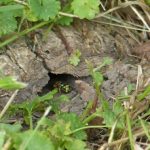As Marion was looking out the window recently she saw Rich abandon the lawn mower and race across the yard swatting and jumping as he ran. What was going on?
He’d pushed the mower up close to wood mulch around a tree and disturbed a Yellow Jacket nest. They boiled out of their underground home and attacked. Rich was stung five times as they chased him across the yard.
Many people have unpleasant encounters with this aggressive insect every year, especially in late summer. Their stings are painful and it’s a rare and fortunate person who only gets stung once. Multiple stings are normal. First, get away from the nest and alert everyone else around about the nest. Then, put ice on the stings to keep swelling down. Watch for and treat more serious allergic reactions.
The life history of Yellow Jackets is interesting. Many species live in the United States. Some, like the German yellow jacket, are exotic while others are native. Most have the familiar yellow and black pattern, although a few species may be black and white. Only the queen overwinters, and in spring she makes a nest that’s usually underground but can be found in other locations. She’s an egg laying machine. By late summer the colony can have thousands of members.
This insect is generally beneficial. Adults eat a wide array of fruits, meat, sweets and insects but normally they feed their larvae insect parts. Although they consume pesky insects, they often forage in trash cans and they love picnics. A definite problem because there is nothing beneficial about being stung many times. The experience can be traumatic to a child.
Yellow jackets don’t go out of their way to sting, but they do readily attack anything they believe threatens their home. Generally they won’t attack a person walking quietly in the area. But anyone who disturbs the leaves or sticks near their entry hole will be chased by dozens of yellow jackets as they boil out of their nest and attack.
If the nest is in a place with much human traffic, it is prudent to destroy it. That requires pinpointing the entry. To find it, carefully approach the area where the nest is suspected. Look for a small hole, often under a piece of wood, with insects coming and going. Avoid making noise or disturbing leaves, mulch, or wood. A pair of close focusing binoculars can aid in the search. Once the entry is located follow these steps:
- Wait until after dark when all insects are down in the nest.
- Approach the entry hole with a flashlight, a spray can of wasp killer, and a piece of carpet.
- Spray the poison down the hole and cover it with the carpet to keep fumes and insects inside.
Remember to only destroy a nest if the insects pose a stinging threat. Otherwise leave it alone for these beneficial, although cranky insects to live.
A side note is that several colleges and universities like Georgia Tech and Black Hills State University sport the Yellow Jackets as their mascot. Appropriate Buzz and Sting!



Timing terrific on this article! Really interesting fact on that overwintering queen. Think I’m ever so slightly more sympathetic to these fiends.
Thanks, Sigi!